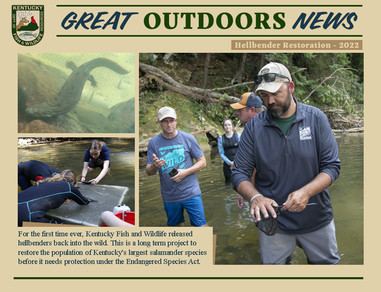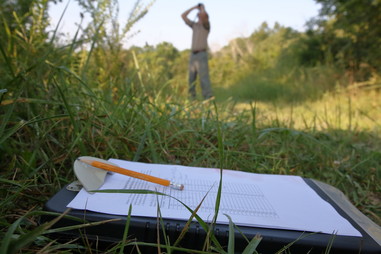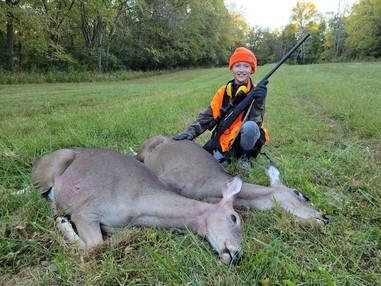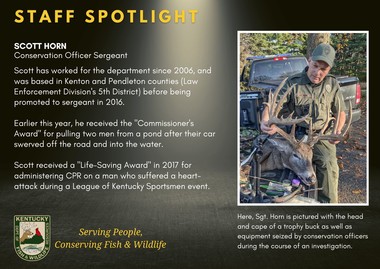 (Graphic by Rachel Cummings)
In conjunction with researchers from Purdue University, Kentucky Department of Fish and Wildlife Resources staff collected hellbender egg masses in Kentucky streams to raise them in a lab environment. This increased the survival of the hellbender young by 50 times what is observed in the wild.
After being raised for several years in the lab, the hellbenders were recently released into Kentucky streams. It marked the first release of lab-raised hellbenders into Kentucky. This long term restoration effort is expected to increase the species' population to prevent listing under the Endangered Species Act.
Watch a Kentucky Afield TV segment about this effort: https://youtu.be/5NAixeJ5E6U

Federal authorities have confirmed the presence of avian flu in waterfowl in Jefferson County, the first time the virus has been detected in wild birds in Kentucky since May.
The U.S. Department of Agriculture's (USDA) National Veterinary Services Laboratories confirmed the presence of highly pathogenic avian influenza (HPAI) in samples from two different waterfowl species collected at a neighborhood pond in Jefferson County on Oct. 5. This follows detection of the same virus in domestic, backyard flocks in Fayette and Logan Counties earlier this month.
The current outbreak of HPAI is having significant impacts on wild birds and can devastate commercial and backyard flocks. Transmission can occur several ways. Domestic birds can be exposed to the virus from contaminated clothing, boots, and equipment as well as from wild birds or their feces. It is important to practice good biosecurity and keep domestic birds isolated from other flocks.
The risk to human health posed by HPAI in wild birds and domestic poultry is low. Meat or eggs harvested from wild or domestic birds does not present a food safety risk when handled and cooked properly. Further information for hunters and other individuals that handle wild birds is available on the department's website (fw.ky.gov).
Read more
(Photo by John Brunjes)
|

Simplified bear hunting regulations are now in place in Kentucky.
Regulation changes proposed by the Kentucky Fish and Wildlife Commission received final legislative approval on Oct. 20.
Gone are the eight zones and harvest quotas that shut down a season once a set number of female bears was harvested. The newly amended regulations establish fixed season dates with no bear quotas, making it easier for hunters to plan their trips. Regulations also reduce the number of hunting zones to two.
The new regulations are reflected in the updated online version of the Kentucky Hunting and Trapping Guide.
The Kentucky Fish and Wildlife Commission proposed the new bear season changes in September 2021; regulation changes were being promulgated since that time and became effective upon conclusion of the Oct. 20 meeting of the Interim Joint Committee on Natural Resources and Energy.
Kentucky reopened to bear hunting in 2009 as populations expanded from surrounding states. Quotas were originally enacted to allow bears to establish a self-sustaining population through natural dispersion. Now, with Kentucky's growing bear population established, harvests can be regulated by the number of days each season remains open. Special Bear Reserves already in place add a layer of sustainability.
Hunters still are limited to one bear per license year.
Read more
(Photo by Steven Dobey)
|
 (File photo)
Many species rely on hard mast for nutrition through the fall and winter months, and the statewide mast survey conducted by Kentucky Fish and Wildlife determines what percentage of hickory, red oak, white oak and American beech trees are bearing hard mast across the state.
Cody Rhoden, small game program coordinator with Kentucky Fish and Wildlife, coordinates the department’s statewide survey with Zak Danks, wild turkey and ruffed grouse program coordinator for the department.
This year, white and red oak acorn production rated average (similar to last year) while hickory nut and beech nut production rated poor (down from last year).
Annual hard mast production, or the number of acorns and nuts produced by Kentucky’s hardwood trees, influences whitetail behavior throughout the season as a deer’s primary food source. Higher amounts of hardwood mast in Kentucky’s forests leads to fewer encounters with animals, including deer, Rhoden said. The opposite is true for times of lean mast, which may result in higher harvest rates of game animals, such as squirrels and deer as these animals must move more to find food, he added.
View the 2022 Mast Survey Report
 Followers of the Fisheries District accounts on Twitter have been treated to - and enticed by - photos of hefty bass as biologists have conducted survey work in recent weeks.
Pictured on the top row (l-r): Marcy Anderson (Southeastern District), Jason Russell (Eastern District), David Baker (Central District); Bottom row (l-r): Mark Harless (Eastern District), Jeff Crosby (Central District), Maddy Ruble (Northwestern District). A complete listing of Fisheries District Twitter accounts can be found online at fw.ky.gov or by clicking the image above..
Each fall, as part of the department’s Bass Stocking Initiative (BSI), district fisheries biologists survey for largemouth bass in lakes to determine the success of the spring spawn. To do this, biologists collect largemouth bass by electrofishing and then release them immediately back into the lake after collecting the necessary data.
The information from these efforts is used to determine which lakes will receive supplemental stocking of largemouth bass.
The department's Minor Clark Fish Hatchery in Rowan County raises largemouth bass to larger stocking sizes (around 5 inches) for this purpose. The larger fingerlings have better odds of survival after stocking, thereby helping to augment largemouth bass numbers in lakes where natural spawns were lowest. This helps ensure lakes maintain quality largemouth fisheries. With a limited number of fish available from the hatchery, the BSI procedure ensures the fish are stocked where most needed.
Also, during fall surveys, biologists evaluate the condition of many of the sportfish populations by taking data on numbers, size and weight.
 Ashton Lacefield with two does harvested during the youth-only weekend earlier this month. (Photo by Joe Lacefield.)
The 2022-23 deer season is off to a strong start, raising expectations for the weeks ahead.
Archery and crossbow hunters posted the second-highest harvest total on record for September, and October’s numbers are up over last year.
The 3,892 deer taken with a firearm during the Oct. 8-9 youth only gun season was more than double the number taken in the same season last year. The early muzzleloader weekend on Oct. 15-16 saw hunters harvest 3,231 deer with muzzleloaders.
The modern gun deer season opens Nov. 12. Last year, the 16-day season accounted for 73 percent of the more than 132,000 deer that hunters reported taking across all seasons.
The dry conditions observed during the late summer and this fall across the Commonwealth will likely lead to early mast drop of all hardwood species, meaning available hard mast could be exhausted sooner. In that scenario, experts expect deer will be on the move in search of food later in the hunting seasons, which could make a late fall or early winter food plot a productive spot.
Keep up with the latest deer season harvest results for your county, region or public lands on the department's website (fw.ky.gov).
 Chase Wininger, Kentucky Afield TV executive producer, holds a chunky hybrid striped bass he caught from the Ohio River at the Falls of the Ohio in early October. (Photo by Lee McClellan)
In the latest installment of the “Fall Fishing Festival" series, Kentucky Afield Magazine Associate Editor Lee McClellan highlights hybrid striped bass opportunities across the state.
Find this article and others in the series on the Fall Fishing Festival page.
 Meet Scott Horn, a conservation officer sergeant with the department.
Interesting fact about Scott: He has been involved with numerous investigations over the course of his 16-year career, including a case in which a well-known trophy buck was poached in northern Kenton County.
“Staff Spotlight” introduces you to the variety of our employees and the breadth of their expertise, as well as the diversity of jobs, programs and initiatives of the department.
To learn more about current employment opportunities with Kentucky Fish and Wildlife, please visit fw.ky.gov/careers.
Conservation Officers Andy Amburgey (back row, left) and Barry McCoy (back row, right) recently visited with students at Montogmery Christian Academy. (Photo provided by Commissioner Rich Storm) |